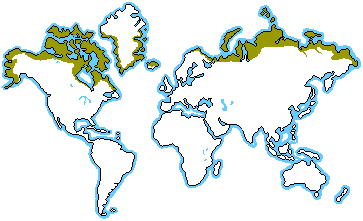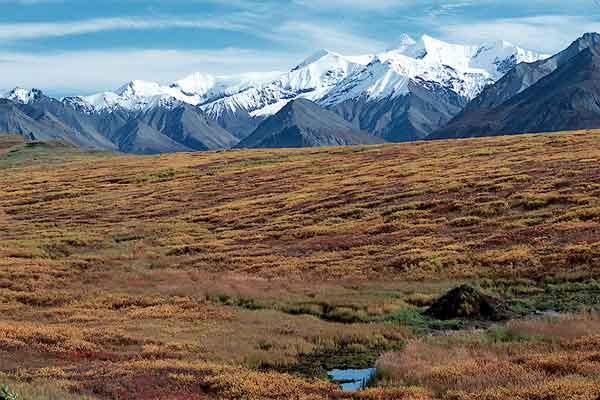Friday, February 17, 2012
How have animal and plants evolved to survive in this region? What are some unique traits they have to cope with the conditions?
Animal Adaptations:
- short and stocky arms and legs
- thick, insulating cover of feathers or fur
- thick fat layer gained quickly during spring in order to have continual energy and warmth during winter months.
- many tundra animals have adapted especially to prevent their bodily fluids from freezing solid.
- resident animals like the ptarmigan and the ground squirrel use solar heating to stay warm and save energy.
Unique Tundra Plant Characteristics:
- can withstand extremely low temperatures, wind, and drought
- don't have tap roots
Works Cited
"Alpine Biome." Blue Planet Biomes. Web. 17 Feb. 2012. <http://www.blueplanetbiomes.org/tundra.htm>.
Carter, Karen. "Soil Conditions of the Tundra | EHow.com." EHow | How to Videos, Articles & More - Discover the Expert in You. | EHow.com. Web. 17 Feb. 2012. <http://www.ehow.com/facts_7472193_soil-conditions-tundra.html>.
Hewitt, Sally. "Habitats." Web. 17 Feb. 2012. <http://www.scsd.us/~bellevue/Habitats.htm>.
"Index." MIT - Massachusetts Institute of Technology. Web. 17 Feb. 2012. <http://web.mit.edu/12.000/www/m2007/teams/amostai/>.
"ScienceDaily: Environmental Science Articles." Science Daily: News & Articles in Science, Health, Environment & Technology. Web. 17 Feb. 2012. <http://www.sciencedaily.com/articles/earth_climate/environmental_science/>.
"Tundra Biome - YouTube." YouTube - Broadcast Yourself. Web. 17 Feb. 2012. <http://www.youtube.com/watch?v=pgyJP9Ciwoc>.
"Tundra Threats, Tundra Species - National Geographic." Environment Facts, Environment Science, Global Warming, Natural Disasters, Ecosystems, Green Living - National Geographic. Web. 17 Feb. 2012. <http://environment.nationalgeographic.com/environment/habitats/tundra-threats/>.
Carter, Karen. "Soil Conditions of the Tundra | EHow.com." EHow | How to Videos, Articles & More - Discover the Expert in You. | EHow.com. Web. 17 Feb. 2012. <http://www.ehow.com/facts_7472193_soil-conditions-tundra.html>.
Hewitt, Sally. "Habitats." Web. 17 Feb. 2012. <http://www.scsd.us/~bellevue/Habitats.htm>.
"Index." MIT - Massachusetts Institute of Technology. Web. 17 Feb. 2012. <http://web.mit.edu/12.000/www/m2007/teams/amostai/>.
"ScienceDaily: Environmental Science Articles." Science Daily: News & Articles in Science, Health, Environment & Technology. Web. 17 Feb. 2012. <http://www.sciencedaily.com/articles/earth_climate/environmental_science/>.
"Tundra Biome - YouTube." YouTube - Broadcast Yourself. Web. 17 Feb. 2012. <http://www.youtube.com/watch?v=pgyJP9Ciwoc>.
"Tundra Threats, Tundra Species - National Geographic." Environment Facts, Environment Science, Global Warming, Natural Disasters, Ecosystems, Green Living - National Geographic. Web. 17 Feb. 2012. <http://environment.nationalgeographic.com/environment/habitats/tundra-threats/>.
•coldest of all biomes
•short growing season, low precipitation, few nutrients, low bio diversity
•located far north of Greenland, Alaska, Canada, Europe, and Russia
•short growing season, low precipitation, few nutrients, low bio diversity
•located far north of Greenland, Alaska, Canada, Europe, and Russia
Anthropogenic Environmental Threats
Global Warming!
•Many scientists believe that global warming caused by greenhouse gases may result in elimination of Arctic regions including the tundras
•Since 1/3 of world's soil-bound carbon is in permafrost so as this starts to thaw, its organic contents begin to decay which releases carbon dioxide
•Especially vulnerable because the tundra is slow to repair itself from physical disturbances
•Ozone depletion means stronger UV rays will hit
Soil Conditions
•Gravel and fine inorganic materials make up the thin top soil
•Nutrients and energy left by dead organic matter is used for plant growth
•Subsoil zone is permanently frozen which prevents plant roots and water from reaching deep into the ground
•Soil above permafrost is soggy during the summer
•Very sensitive to ground disruption
•Disturbed ground soil is subject to the thawing of permafrost, creation of sink holes due to the ground collapsing, and loss of the already scarce top soil
Thursday, February 16, 2012
Keystone Species
http://kiwi6.com/file/b38431c5jx (Play MP3 for voiceover.)
http://kiwi6.com/file/7877f2841c (Play MP3 for voiceover.)
Subscribe to:
Comments (Atom)






















